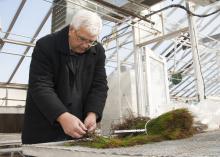Information Possibly Outdated
The information presented on this page was originally released on April 16, 2015. It may not be outdated, but please search our site for more current information. If you plan to quote or reference this information in a publication, please check with the Extension specialist or author before proceeding.
MSU forestry work shows the value of good seedlings
By Bonnie Coblentz
MSU Ag Communications
STARKVILLE, Miss. -- A forest geneticist at Mississippi State University is encouraging landowners to invest in better seedlings, and he’s giving them free trees so they can see for themselves that the results are worth the much higher initial cost.
Randy Rousseau, an MSU Extension and research professor in the Forest and Wildlife Research Center, developed the Land Owner Tree Improvement Cooperative, which he now administers. In 2014, he provided information to a large number of County Forestry Associations focused on helping landowners increase revenue from their pine stands by planting high-level genetic seedlings.
“From these presentations, we surveyed the participants to see if they might be interested in planting such seedlings on their property,” Rousseau said. “I took this idea to ArborGen, and they agreed to donate the seedlings.”
By late 2014, 14 landowners agreed to establish three different loblolly genetic types on their land.
“I selected three different pine varietals based on growth form and disease resistance,” Rousseau said. “These are significantly higher quality seedlings than those often purchased and planted after a harvest. The price of these varietal seedlings is high because of the technology it takes to produce them.”
Rousseau’s plan is as old as the Extension Service, which celebrated its centennial in 2014.
“We’re letting landowners plant these trees on their land and letting them and their neighbors watch the results,” he said. “However, each site will be measured by MSU personnel and the results distributed to all of the participating landowners, so they can see how these trees are doing across the entire state.”
The project is focused on two problems facing landowners: a depressed pulpwood market and the fact that Mississippians grow a substantial amount of timber that is intended for that market.
“We’re trying to move toward planting fewer trees but getting more trees of higher quality on Mississippi forestland,” Rousseau said. “We want landowners to be able to produce a better, high-end lumber product. We want more wood that is of the quality for use as saw timber, veneer or utility poles.”
Rousseau said since timber produced from genetically superior trees is significantly higher in quality, landowners can expect to earn higher returns.
But getting landowners to pay 40 cents a seedling rather than 7 cents each is a hard sell. For the last two years, Rousseau has been working with Extension agents and forestry agencies to talk to landowners about the importance of planting seedlings with good genetics. Landowners participating in the cooperative program are located in each of the state’s four districts.
“We’re trying to get landowners away from planting a lot of trees and then thinning them for pulp at 12 years, then selling them at 20 years for more pulpwood and some chip and saw timber,” he said. “We want them to grow fewer trees, but these trees will be of better quality and will bring a higher price at market as saw timber.”
MSU Extension personnel supply each participating landowner with 800 seedlings to plant on a 2-acre plot. Rousseau and other MSU personnel monitor these stands annually, but they do not make management decisions or perform any work on the plot.
“We’re trying to get the landowners more interested in exactly what goes in the ground, because you’re stuck with what you put in the ground,” Rousseau said. “We’re trying to show landowners that properly selected, high-quality-genetic seedlings play a key role in growing more valuable material.”
Rousseau added that genetics alone will not increase timber yields. Superior trees must be combined with good management techniques to provide the increased revenue landowners desire.
Andy Ezell, head of the MSU forestry department, said using improved tree genetics allows landowners to grow better trees faster.
“The industry has made incredible strides in genetics, growth form, disease resistance and rate of growth,” he said. “Along with the genetic improvements have been some improvements in timber management practices.”






